Magazines flourished and offered iconic images and reporting during WWII.
1] Saturday Evening Post – 27 November 1943.
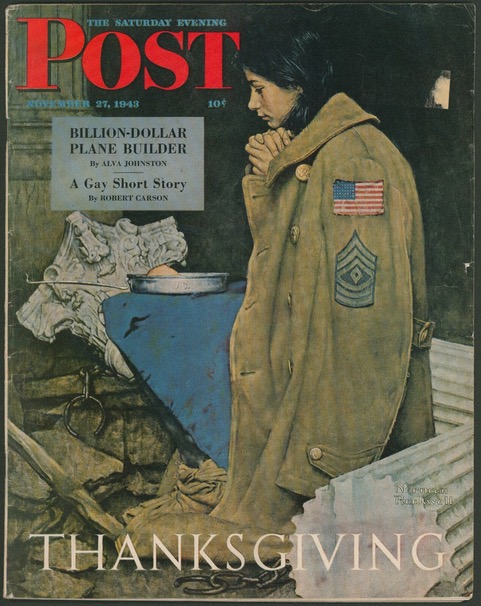
This is a somber cover indeed, featuring my favorite Norman Rockwell illustration from the war, titled “Refugee Thanksgiving.” Rockwell was synonymous with the magazine and created many stunning, memorable covers, but this is, in my opinion, the most impactful, depicting an Italian girl praying with a GI’s combat jacket draped around her shoulders in the ruins of an Italian village or town. This was Rockwell’s way of reminding Americans to consider others, so far away, who were in a war zone—especially vulnerable civilians. By November 1943, the attrition in Italy was utterly discouraging, with the Allies stalled in the mountains and a long, bloody winter ahead. But thanks to great sacrifice, young Italians could at least be grateful for their liberation.
2] Time – 16 November 1942.

This was quite an achievement – the boy from Abilene made the cover of Time magazine. Eisenhower had just successfully led Operation Torch, the Allied invasion of North Africa, when he appeared on the cover. He had passed his first major test, never having led men in combat before. There was a long way to go to reach Berlin, but this was a promising start.
Time opined: “Abilene to Tizi-Ouzou. Commander of this tough, resilient, if somewhat bewildered army, undertaking the greatest military invasion in U.S. history, is Texas-born and Kansas-bred. Fourteen months ago, big, powerful Ike Eisenhower was only a colonel. Forty years ago, he was tending his father’s chickens in Abilene, Kansas. This week, he led a group of top U.S. generals, at least one admiral, and all the expedition’s allied ground, sea, and air units. Under his sharp, blue eyes lies a country filled with names like Tizi-Ouzou, Bougie, and Ksar es-Souk, steeped in an ancient, bloody history associated with figures like Hannibal and Hamilcar.”
3] Fortune – July 1942.
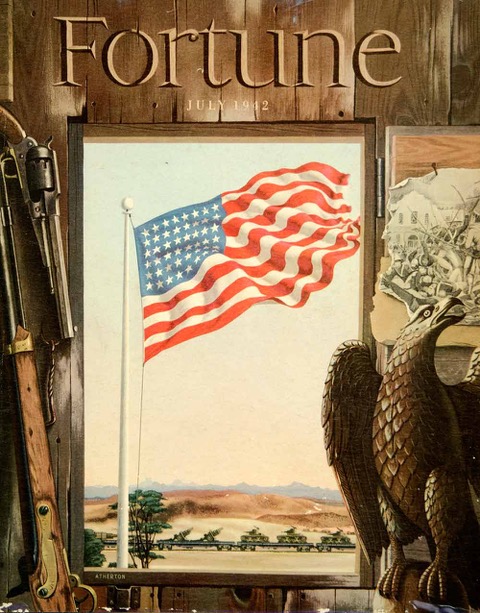
John Atherton’s patriotic cover to celebrate the first Independence Day of the war offers a striking view of America facing global conflict and its extraordinary challenges. For an intriguing look at America during wartime, turn to the distinguished pages of Fortune magazine. The beautifully illustrated and detailed features took readers inside factories, boardrooms, and the corridors of power in Washington D.C. throughout the greatest conflict in human history, showing how the US transformed, mobilized, produced, and unified as a remarkable industrial powerhouse—the guardian of democracy and later the hotbed of mass production that drove victory.
4] The New Yorker – 26 December 1942.
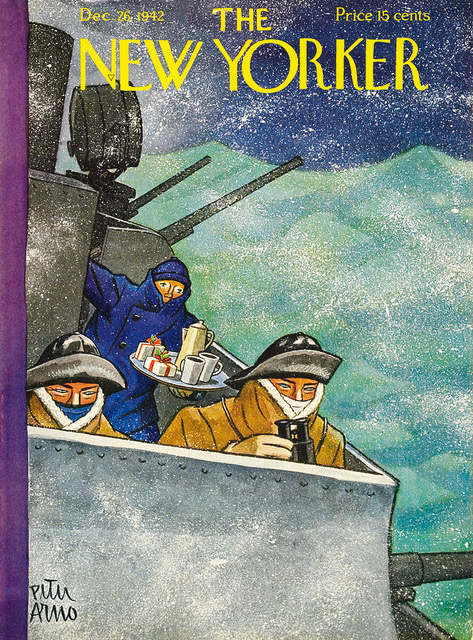
What a glorious, classic New Yorker cover by the underrated Peter Arno. Due to WWII, the magazine shifted from a New York-focused publication to one with a global reach, becoming a model of frontline reporting with outstanding contributors. A.J. Liebling covered D-Day. Mollie Panter-Downes provided a profoundly moving series, “Letter from London,” during the dark weeks of the Blitz in 1940, and most notably, an entire issue was dedicated to the greatest magazine journalism ever published—John Hersey's heart-wrenching, astonishing 1946 account of Hiroshima's hell.
5] Life – 1 February 1943.

In 1936, Henry Luce, the founder of Time magazine, revived Life as a weekly picture magazine, aiming for readers “to see life; to see the world; to eyewitness great events.” Life reached its peak during WWII, becoming the most influential newsweekly and featuring some of the greatest photographers and reporters to ever appear in any magazine.
The magazine quickly became famous for its innovative photo essays, combining powerful images—often taken at great personal risk—with concise text, making it a must-read. Some of the notable photographers featured in its pages include Margaret Bourke-White, Alfred Eisenstaedt, and the legendary Robert Capa, who landed on Omaha Beach and captured arguably the most striking combat photos of all time.
6] Newsweek – 20 May 1940.
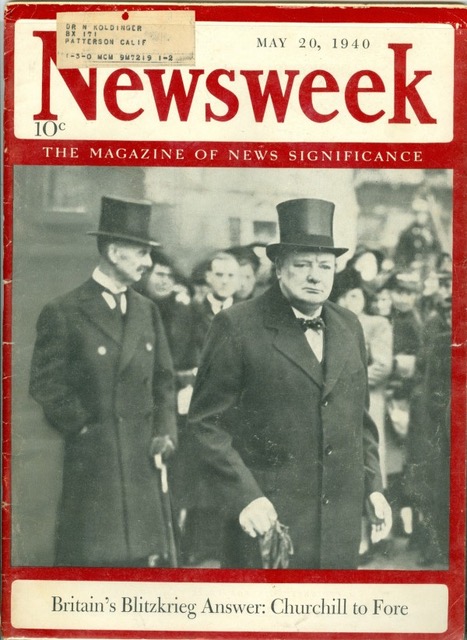
Newsweek was a more reserved, less entertaining rival to Life, but still an excellent source of in-depth news and analysis, much like today’s leading publication, The Economist. This cover is my favorite, showing Winston Churchill in his prime, May 1940, when he became Prime Minister of a country many believed was doomed. Churchill had risen from political obscurity in the 1930s to lead the last surviving democracy in Europe. Through grit, blood, sweat, tears, and superb oratory, he arguably saved Western civilization.
7] Life – 14 May 1945.
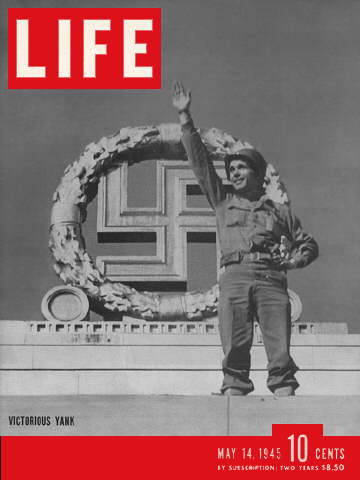
This is a personal favorite. I spent five years researching my book, The Liberator, which recounts the story of Lt. Colonel Felix Sparks, a member of the 45th Infantry Division. The photograph on the cover of Life magazine was taken by the incredible Robert Capa, appearing just a week after the end of the war in Europe, with about 140,000 Americans having fallen in their fight to defeat Nazism. It was actually snapped on April 21 at the Nazi rally grounds in Nuremberg shortly after its liberation. Sparks was present when, after the usual photos of GIs giving a mock Heil Hitler salute, they decided to blow up the massive swastika. Apparently, the explosion threw pieces of concrete dozens of yards, and a chunk of the concrete swastika actually wounded a chaplain.
8] Reader’s Digest – June 1945.
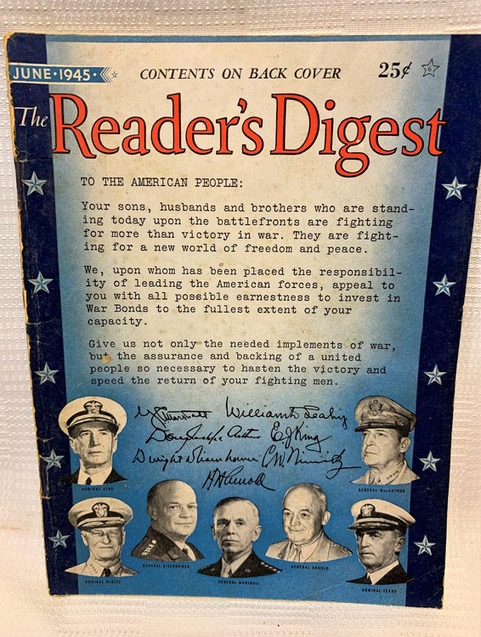
If you want to feel sentimental and understand what made America great by 1945, look no further than this cover. The message from top brass of the US military is a reminder that, as far as the US was concerned, victory wasn’t about conquering and humiliating evil foes. It was about liberation, restoring dignity, and ensuring Americans and many others around the world could live in peace and freedom. This may sound idealistic considering the wars the US has fought since then, but it was genuinely the case.
9] Collier’s – 14 July 1945.

How could you not swoon if you were a red-blooded American soldier upon seeing Carole Landis, the Wisconsin-born bombshell known as “The Chest” because of her figure, and a popular pin-up among Americans fighting in WWII? In 1942, she traveled with comedian Martha Raye, dancer Mitzi Mayfair, and actress Kay Francis, working with the USO in England and North Africa. She also entertained soldiers in the South Pacific alongside Jack Benny. She contracted malaria and amoebic dysentery while covering more than 100,000 miles. Benny later said that Landis was eager to visit hospitals, unlike other entertainers. She, in fact, spent more time visiting troops than any other actress. Tragically, she committed suicide in 1948. In her ten-year career, she appeared in over 40 films.
10] The Saturday Evening Post – 13 October 1945.

This is the second cover from the Saturday Evening Post on this list for a good reason – it is by Norman Rockwell, the greatest illustrator of the magazine’s many iconic covers during the war. This shows a young Marine, back home after Japan's defeat, holding a memento of victory – the Japanese flag. What trauma is he hiding? What will peace bring – freedom from horror, from the recent past? Rockwell created many other images and posters for various government agencies and organizations, such as the U.S. Army Ordnance Corps, to promote factory production and support wounded and disabled veterans. An outstanding painter, Rockwell had a gentle yet perceptive eye and captured the perfect tone, a mix of longing for peaceful times and a straightforward patriotism that was uniquely American.